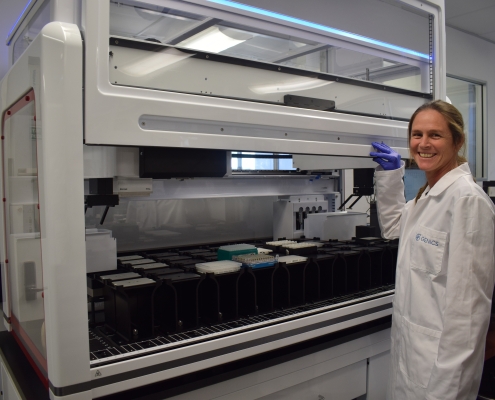Genics Shrimp Multipath exceeds world standards in pathogen testing.
WSSV infected Penaeus monodon. Credit: Dr Ben Diggles.
White Spot Syndrome Virus (WSSV) is one of the most notoriously feared infectious agents in the shrimp industry, inflicting estimated production losses world-wide of up to US$1 billion annually. It moves quickly, killing up to 100% in affected farmed shrimp.
Now, a home-grown innovation by Queensland biotech success story, Genics, has been proven to exceed the standards for efficiency and sensitivity in commercial shrimp pathogen tests, used to identify pathogens like WSSV.
Global testing standards for the devastating white spot virus are currently set by the World Organisation for Animal Health (WOAH), and Australia’s national science agency, CSIRO.
Dr Melony Sellars, inventor of Shrimp MultiPath™ technology, and CEO of Genics said, “I am pleased to share the latest peer reviewed research findings, published by the prestigious Diseases of Aquatic Organisms, supporting the market leading capability of Genics Shrimp MultiPath™ technology.

Dr Melony Sellars at Genics
[popup_trigger id=”8413″ tag=”button” classes=”button”]Request Paper[/popup_trigger]
“Not only are we benchmarking against world standard testing real-time PCR assays, but then also exceeding these parameters, meaning we are supplying our industry with higher efficiency and value for money with this cutting-edge technology against white spot and the 12 other pathogens of commercial importance in the platform.”
The performance of Shrimp MultiPath™ was tested by an independent laboratory, against DNA and RNA clinical samples (i.e. tissue from sick animals) the WOAH-OIE recommended real-time PCR assay and the newly adapted CSIRO real-time PCR assay in an empirical assessment for this study. It was assessed for repeatability, sensitivity, and specificity on Bayesian latent class models, using real-world L. vannamei tissue samples.
Shrimp are well known for their high volumes of protein, amino acids and healthy fats making them an important part of our world’s sustainable food supply. Unfortunately, these little invertebrates can also contract numbers of deadly pathogens [with no human health implications], with many farmers not aware their animals are sick until it is too late, causing millions of dollars of distressing food and stock waste.
Effective surveillance testing and targeted diagnosis as part of cohesive biosecurity measures are all ways that shrimp industries and authorities can receive early alerts about the potential threat of WSSV in populations.
As a Genics reader, this paper can be requested from the authors using the form below.




